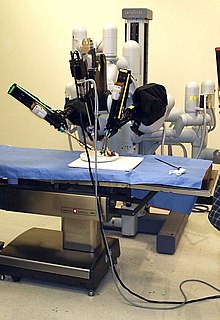Definitions
The word robot can refer to both physical robots and virtual software agents, but the latter are usually referred to as bots.[3] There is no consensus on which machines qualify as robots, but there is general agreement among experts and the public that robots tend to do some or all of the following: move around, operate a mechanical limb, sense and manipulate their environment, and exhibit intelligent behavior, especially behavior which mimics humans or other animals.
There is conflict about whether the term can be applied to remotely operated devices, as the most common usage implies, or solely to devices which are controlled by their software without human intervention. In South Africa, robot is an informal and commonly used term for a set of traffic lights.
Stories of artificial helpers and companions and attempts to create them have a long history but fully autonomous machines only appeared in the 20th century. The first digitally operated and programmable robot, the Unimate, was installed in 1961 to lift hot pieces of metal from a die casting machine and stack them. Today, commercial and industrial robots are in widespread use performing jobs more cheaply or with greater accuracy and reliability than humans. They are also employed for jobs which are too dirty, dangerous or dull to be suitable for humans. Robots are widely used in manufacturing, assembly and packing, transport, earth and space exploration, surgery, weaponry, laboratory research, and mass production of consumer and industrial goods.[4]
It is difficult to compare numbers of robots in different countries, since there are different definitions of what a "robot" is. The International Organization for Standardization gives a definition of robot in ISO 8373: "an automatically controlled, reprogrammable, multipurpose, manipulator programmable in three or more axes, which may be either fixed in place or mobile for use in industrial automation applications."[5] This definition is used by the International Federation of Robotics, the European Robotics Research Network (EURON), and many national standards committees.[6]
The Robotics Institute of America (RIA) uses a broader definition: a robot is a "re-programmable multi-functional manipulator designed to move materials, parts, tools, or specialized devices through variable programmed motions for the performance of a variety of tasks."[7] The RIA subdivides robots into four classes: devices that manipulate objects with manual control, automated devices that manipulate objects with predetermined cycles, programmable and servo-controlled robots with continuous point-to-point trajectories, and robots of this last type which also acquire information from the environment and move intelligently in response.
There is no one definition of robot which satisfies everyone, and many people have their own.[8] For example, Joseph Engelberger, a pioneer in industrial robotics, once remarked: "I can't define a robot, but I know one when I see one."[9] According to Encyclopaedia Britannica, a robot is "any automatically operated machine that replaces human effort, though it may not resemble human beings in appearance or perform functions in a humanlike manner".[10] Merriam-Webster describes a robot as a "machine that looks like a human being and performs various complex acts (as walking or talking) of a human being", or a "device that automatically performs complicated often repetitive tasks", or a "mechanism guided by automatic controls".[11]
Modern robots are usually used in tightly controlled environments such as on assembly lines because they have difficulty responding to unexpected interference. Because of this, most humans rarely encounter robots. However, domestic robots for cleaning and maintenance are increasingly common in and around homes in developed countries, particularly in Japan. Robots can also be found in the miltary

